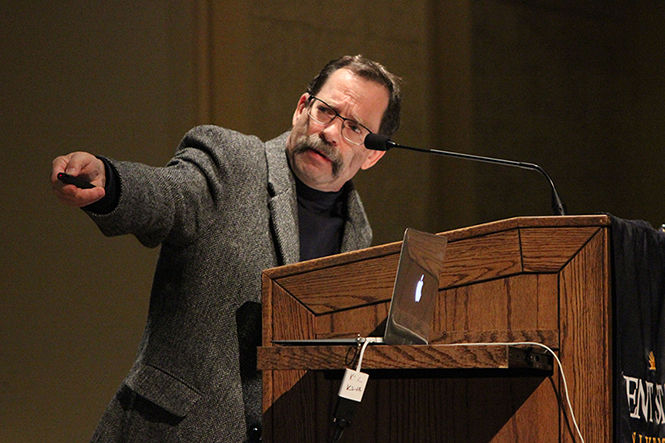Kent State discusses Israeli-Palestine conflict
Joel Beinin, the Donald J. McLachlan Professor of History and Professor of Middle East History at Stanford University speaks about the Israeli-Palestinian conflict in the West Bank in the Kiva on Tuesday, March 3, 2015.
March 3, 2015
Among the many conflicts in the world, nearly all of them have a polarizing effect on the direct population they concern. The conflict between Israel and Palestine is no exception.
“It is one of the most enduring conflicts,” said Joshua Stacher, associate professor of political science at Kent State.
In the Kiva on Tuesday, March 3, Joel Beinin, professor of history and Donald J. McLachlan professor of Middle East history at Stanford University, told an audience consisting of about 50 students, faculty and community members about the effectiveness of high-risk activism against Israeli occupation and the uncertain future of the region in his talk “High-Risk Activism and Popular Struggle Against the Israeli Occupation in the West Bank.”
“Social relationships formed in the course of struggle, not prior to the immediate risk of high risk activism that is sharing intense, emotional moments of fear, victory and defeat and facing violence together are the most important motivators in participation in high-risk activism,” Beinin said.
The event was put on in joint partnership with Kent State’s College of Arts and Sciences and the Northeast Ohio Consortium for Middle East Studies. Before the lecture began, Stacher said that disruptions would not be accepted, as talks concerning the conflict between Israel and Palestine have spurred dissent before.
The conflict between Israel and Palestine goes back decades, and even longer. The establishment of Israel as a state in 1948 was a big spur of conflict between the new nation and neighboring Arab countries. Many aspects go into the conflict, including recognition, borders, water rights, Jerusalem and so on.
Beinin’s speech began with an example in Mississippi during the 1960’s, as an instance of high-risk activism when three people were shot trying to aid in the education and voting rights of African-Americans. He then used multiple villages in the West Bank as examples where rural Palestinians showed examples of high-risk activism, including Jayyous, Zbouba and Mas’ha. Villagers in each worked to disrupt the construction of Israeli barriers, some experiencing more success than others.
Nearly all confrontations involved rubber bullets, tear gas and/or arrests.
Throughout the talk and questions afterwards, it became clear that there was more to it than just a never-ending conflict many are led to believe.
“This is not a religious issue,” said Emily Fullerton, a senior political science major. “It’s a secular civic struggle.”
“What is a conflict often described as ‘Pro-Israel’ and ‘Anti-Israel’ or ‘Pro Palestine’ and ‘Anti-Palestine’ is that it’s much more complicated,” Stacher said. “They don’t break down into these easy classifications.”
Furthermore, a lot of blame shifted to the U.S. and the American media.
“I think (the U.S. media) does a terrible job at people’s understanding of this conflict,” Stacher said
“Generally terrible,” Beinin said, describing the media’s coverage of the conflict. The U.S. is in a very momentous period of decline that isn’t acknowledged, he said.
Overall, the audience was satisfied with the talk, whether they agreed or not, and a light message was presented at the end.
“I thought it was a good talk to have right now in this point in time,” said Elyse Claassen, a senior political science major.
“It is important for people to have a very clear understanding of what is happening in the world. There’s a whole world to learn about,” Beinin said. “This is a story with a lot of hope behind it.”
Contact Skye McEowen at [email protected].












